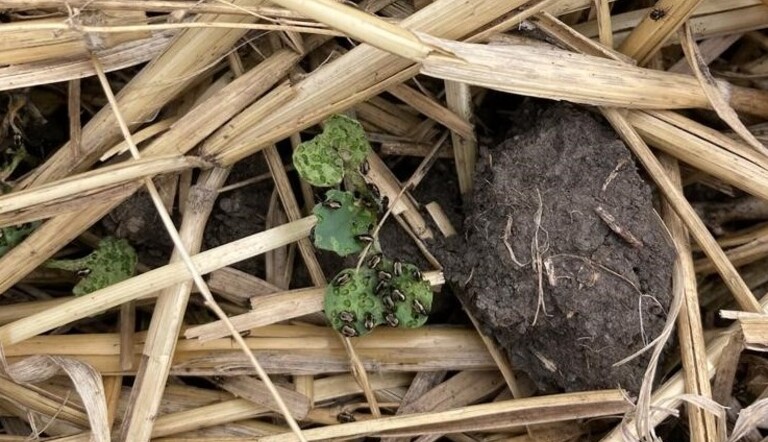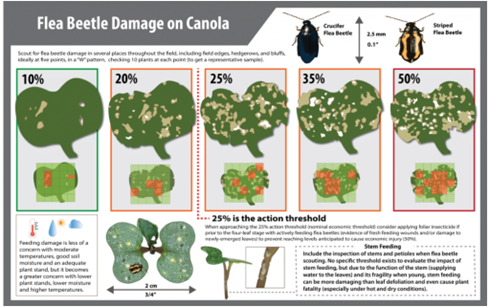
Pest Profile: Flea Beetle

Description and life cycle:
- Feeds on plants of the mustard family (Canola, mustard, and related cruciferous plants and weeds)
- Adults are 2-3mm long, oval beetles
- Eight different flea beetles can be found in Canada, but two species are problematic across the prairies
- Crucifer flea beetle(Phyllotreta Cruciferae) (Goeze)
- Shiny Bluish Black in colour
- Striped flea beetle(Phyllotreta striolata)(Fabricius)
- Black with 2 yellow strips along back
- Crucifer flea beetle(Phyllotreta Cruciferae) (Goeze)
- Eight different flea beetles can be found in Canada, but two species are problematic across the prairies
- Mature larvae are up to 6mm long
- Eggs are .38-.46mm long
Crop Damage (caused by both adults and larvae):
- Adults feed on cotyledons and first true leaves in spring, under windy, damp conditions. Will resort to stem feeding, which causes breakage or wilting
- Mature larvae feed on roots of host plants, having minimal impact
- Feeds on root hairs and taproots of seedlings then pupate
- Striped flea beetles emerge first, than crucifer, but temperature dictates emergence
- Peak occurrence of flea beetles is when temperature reaches 15 degrees
Lifecycle:
- One generation per year but appear twice during the growing season
- Overwinter as adults in leaf litter near soil surface. Emerge as weather warms up in April
- Females lay eggs late May, eggs must come into contact with moist soil or will die off
- Eggs hatch in approx. 12 days
- The white Larvae feed and mature into pupae by early to mid July lasting approx. 7-9 days
- Adult emergence happens again mid-July to late fall where the adults overwinter in leaf debris
- Development from egg to adult takes about seven weeks
Canola Crop Thresholds:
Canola/Mustard – evaluate leaf defoliation, inspecting stems and petioles for feeding damage.
Start scouting from field margins as soon as canola is emerging from the ground in the spring. Looking for shot-hole feeding damage to cotyledons or stem feeding under windy conditions. Daily monitoring maybe needed under hot, dry conditions as seedling development is slow. Ceasing monitoring when the second true leaves appear or adult activity ceases.
Canola can withstand up to 50% leaf loss without significant yield penalty. 25'% leaf loss is the action threshold as leaf loss can escalate quickly in a single day. Stem feeding is more detrimental and when that occurs damage increases to 100% and a foliar application is needed. AT 25% leaf loss growers have time to control damage reducing the risk of beetles reaching a level where yield loss in imminent as plant counts have decreased to much.
Control Options:
Contact products are highly effective.
ADAMA's Portfolio:
| Product/Active Ingredient | Registered Crops |
|
Lambda-cyhalothrin (Contact only) |
Canola, Mustard |
***ALWAYS REFERENCE PRODUCT LABEL BEFORE USE***
Practical Tips:
- There are no known natural predators to help control flea beetles
- Ensuring canola/mustard is treated with a seed treatment offering increased control for flea beetles is a must. There are several different options in the market.
- Good stand establishment is also key that encourages rapid seedling growth which reduces the flea beetle impact. Agronomic impacts under your control should be evaluated when planting canola such as volunteer canola competition, seeding depth, seeding rate, row spacing and tillage.
- The active ingredient in SILENCER® 120 EC or ZIVATA™ /Lambda-cyhalothrin targets the nervous system of insects, specifically the sodium channel. Insect biology is such that the sodium channel is not active when temperatures are high. To achieve optimal efficacy, applications should be made when temperatures are at or below 25ºC.
Referenced literature and additional information:
Canola Council of Canada. Canola Encyclopedia https://www.canolacouncil.org/canola-encyclopedia/insects/flea-beetles/
Minister of Agriculture ad Agri-Food Canada (2018). Field Crop and Forage Pests and their Natural Enemies in Western Canada: Identification and Management. https://publications.gc.ca/collections/collection_2018/aac-aafc/A59-23-2018-eng.pdf
Saskatchewan Ministry of Agriculture. (2023). 2023 Crop Diagnostic Handbook. https://publications.saskatchewan.ca/#/products/118582
Saskatchewan Ministry of Agriculture. (2025). Guide to Crop Protection 2025.
